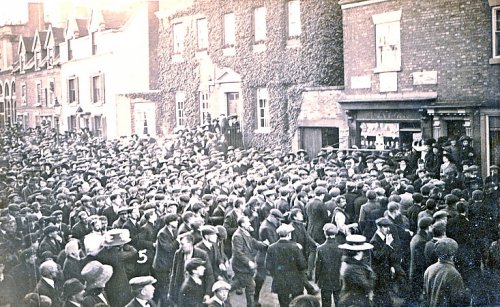This school was founded because “for lack of education, the inhabitants were given over to wickedness and vices such as idleness, swearing, drunkenness, whoredom and such like"!
Five townsfolk, including the Lord of the Manor, Sir Thomas Cockayne, petitioned Queen Elizabeth I for a school in Ashbourne on the grounds that “for lack of education, the inhabitants were given over to wickedness and vices such as idleness, swearing, drunkenness, whoredom and such like"! The Queen signed a Charter agreeing to a school and building work commenced in 1586, but was not finished until 1603, probably due to a lack of carts to carry the roof timbers. The School had a Master, who had to be from Oxford or Cambridge University, an Usher (or Undermaster) and a part-time bell-ringer. The School was endowed with land to pay for the scholars education; only boys were admitted, aged between 6 and 9; they had to be able to read and write and were assessed for their religious knowledge and morality. In 1903, a new school (the present QEGS) was opened at the other end of town and girls were admitted for the first time. The County Council proposed demolishing the Old School, but it was saved thanks to the Derbyshire Archaeological Society. For a time, the Old School was used as a dormitory for boys who boarded at QEGS; girls lived with the Headmaster in the Mansion on the other side of the Church Street. The building is now private dwellings.
Built of Ashlar Stone at a time when most of the buildings in the Town would have been timber framed. The Old School has 2 main stories with attics above. The front is symmetrical with 4 small gables in the middle over the schoolroom and 2 larger ones on the sides over the Masters and Ushers houses. The ground floor has mullioned and transomed windows, whilst the upper floor and gables have low mullioned windows with arched heads. The stone-faced brick extension to the Master’s House was added in 1751-3. There is a moulded head above the left hand doorway showing the School’s coat of Arms, which were derived from those of the Cockayne family. The stones in front of the school were taken from the River Dove and were laid by the Scholars in 1607. Note the old graffiti carved into the building.
The Rev William Langley was the Head Master of The Old Grammar School for nearly 43 years in the late 1700s.
Local tradition is that there are 2 ghosts associated with the Old Grammar School.
Probably the best known of the 15 remaining Festival Football games played in Britain, the game at Ashbourne is takes place throughout the streets each year on Shrove Tuesday and Ash Wednesday. The boundary between the two teams, Upards and Downards, is the Scolebrook/Henmore Brook.













